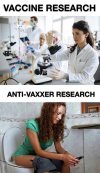Tässähän tapetaan porukkaa ihan tarkoituksella. Israelilaisten kokemuksiahttps://rumble.com/vmpbh3-38132823.html
Lalli? Lalliiiiii!!!! Lalli herrajumala, mikä sinulle tuli!?!?
No, vaatiihan miehiä taistelukin, saati koronapiikin vastustus.
Follow along with the video below to see how to install our site as a web app on your home screen.
Note: This feature may not be available in some browsers.
Tässähän tapetaan porukkaa ihan tarkoituksella. Israelilaisten kokemuksiahttps://rumble.com/vmpbh3-38132823.html
https://www.verkkouutiset.fi/tavoit...tieteilijan-mukaan-se-pitaisi-sanoa/#598788f4Laki mahdollistaisi pakolliset rokotukset. Asiantuntijat pitävät kynnystä kuitenkin korkeana.
Provider identification according to § 5 TMG:Ossi loistaa.
Paitsi ettei tuollaista instituuttia ole olemassakaan. Käyttävät nimeä, joka hämäävästi muistuttaa Reutlingenissa oikeasti sijaitsevan patologisen instituutin nimeä.

Pathologen-Pressekonferenz: Angebliche Befunde zu Impftoten - WELT
Zwei Pathologen im Ruhestand haben über YouTube angebliche Beweise für unerkannte Impftote vorgestellt. Bei einer Pressekonferenz präsentierten sie mikroskopische Aufnahmen, die massive Entzündungsreaktionen belegen sollen. Fachkollegen, die sich den Vortrag angesehen haben, äußern sich entsetzt.www.welt.de
Provider identification according to § 5 TMG:
Institut Prof. Dr. Burkhardt
Obere Wässere 3-7
72764 Reutlingen
Contact: [email protected]
Oikea nimi yllä. Ei löydy google hauissa oikeastaa mitää aiempaa toimintaa tuolla. https://www.google.com/search?q="Institut+Prof.+Dr.+Burkhardt"
Prof. Dr. Burkhardt https://www.google.com/search?q="Prof.+Dr.+Burkhardt"
 Tissi Oohosen ja QAno Turtiaisen levittämiä juttuja seuratessa tulee aina tämä mieleen.
Tissi Oohosen ja QAno Turtiaisen levittämiä juttuja seuratessa tulee aina tämä mieleen.

Ossi loistaa.
Paitsi ettei tuollaista instituuttia ole olemassakaan. Käyttävät nimeä, joka hämäävästi muistuttaa Reutlingenissa oikeasti sijaitsevan patologisen instituutin nimeä.

Pathologen-Pressekonferenz: Angebliche Befunde zu Impftoten - WELT
Zwei Pathologen im Ruhestand haben über YouTube angebliche Beweise für unerkannte Impftote vorgestellt. Bei einer Pressekonferenz präsentierten sie mikroskopische Aufnahmen, die massive Entzündungsreaktionen belegen sollen. Fachkollegen, die sich den Vortrag angesehen haben, äußern sich entsetzt.www.welt.de
https://www.is.fi/ulkomaat/art-2000008290311.htmlTrunsky kirjoitti vakavasti sairaasta potilaasta, joka kiisti koko covid-19-diagnoosin. Toinen potilas taas uhkasi soittaa asianajajalleen, jos hänelle ei annettaisi loislääke ivermektiiniä, jota käytetään muun muassa päätäiden häätämisen. Lääkettä ei ole hyväksytty covid-19-taudin hoitoon. Kolmas potilas kertoi mieluummin kuolevansa kuin ottavansa edes ensimmäisen koronavirusrokotteen.

Itse olin tänään myös testissä. Alkaa niihinkin tottua. Tämä oli kolmas mulle.Mäkin oon nyt ollu 1kk sisällä 2 kertaa kipee. Viikon kerkesin olla terveenä. Lauantaista saakka yskiny. Harvinaisen veemäistä ku nenävuotaa ja yskittää ihan kivasti. Sielutesti oli nega.
Taidan jättää kakkospiikin väliin, jääkön usa tältä vuodelta,ei minkäälaista lentsua,emäntä kaksi kertaa rokotettu vähän väliä kipee ,taas jossain keuhko kuvassa.


Tässä olikin uutisissa sivumainintana (taas) se perusasia.
THL ei panikoi aiemmin sairastaneiden rokottamista.
----
THL:n ylilääkäri Nohynek sanoo, että koronarokotteiden sivuvaikutukset voivat olla voimakkaampia sairastetun taudin jälkeen. ...
Omassa suosituksessamme sanomme, että ihmisellä, joka on sairastanut taudin, ei ole mitään kiirettä saada ensimmäistä rokoteannostaan tai myöskään sitä tehosteannosta, Nohynek sanoo.

Charlotte Kalla sanoo koronarokotteen olleen tautia pahempi – näin asiantuntija kommentoi
Maastohiihdon ruotsalaistähti Charlotte Kalla kertoi Expressenille, että koronarokote iski häneen voimakkaammin kuin itse tauti. THL:n ylilääkäri Hanna Nohynek kommentoi MTV Urheilulle, että sivuvaikutukset voivat olla voimakkaampia sairastetun taudin jälkeen.www.mtvuutiset.fi
---
Kova meteli siitä, että "asiantuntijoita täytyy uskoa", mutta ne eivät edes tuolla median paremmissa piireissä siihen pysty. Esimerkiksi alemman videon, Reutersin selostus presidentti Bolsanarosta, on lievästi sanottuna psykoottinen. Ukkohan on taudin sairastanut.
Pitäisi sen maalaisjärjenkin sanoa, että sairastettu tauti on sama kuin rokote, mutta se on poliittisesti epäkorrektia.
